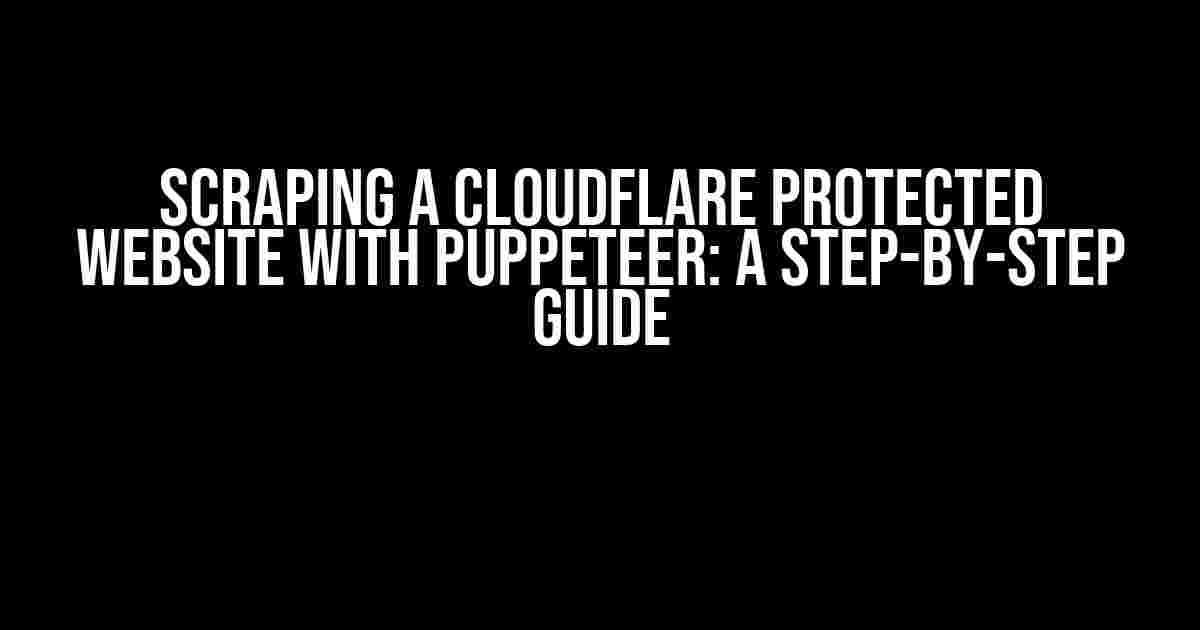Web scraping has become an essential tool for data extraction, monitoring, and analysis. However, many websites employ CloudFlare’s protection to prevent scrapers from accessing their content. In this article, we’ll delve into the world of web scraping and explore how to bypass CloudFlare’s defenses using Puppeteer, a powerful Node.js library developed by the Chrome team.
What is CloudFlare?
CloudFlare is a content delivery network (CDN) that provides security, performance, and reliability to websites. One of its key features is its ability to detect and block scraping attempts, making it a significant obstacle for web scrapers.
How CloudFlare Detects Scrapers
CloudFlare uses various techniques to identify and block scrapers, including:
- IP blocking: CloudFlare can block IP addresses that make excessive requests or exhibit suspicious behavior.
- User-Agent rotation: CloudFlare checks the User-Agent header to identify bots and scrapers.
- Rate limiting: CloudFlare restricts the number of requests from a single IP address within a given time frame.
- Challenges: CloudFlare presents CAPTCHAs or other challenges to verify that the request is coming from a legitimate user.
What is Puppeteer?
Puppeteer is a Node.js library developed by the Chrome team that provides a high-level API to control a headless Chrome browser instance. It allows developers to automate browser interactions, making it an ideal tool for web scraping.
Why Use Puppeteer for Scraping?
Puppeteer offers several advantages for web scraping:
- Accurate rendering: Puppeteer uses a real Chrome browser instance, ensuring accurate rendering of websites.
- Flexibility: Puppeteer provides a wide range of customization options, allowing developers to tailor their scraping approach.
- Ease of use: Puppeteer’s API is intuitive and easy to use, even for developers without extensive web scraping experience.
Scraping a CloudFlare Protected Website with Puppeteer
Now that we’ve covered the basics, let’s dive into the step-by-step process of scraping a CloudFlare protected website using Puppeteer.
Step 1: Install Puppeteer
npm install puppeteerStep 2: Launch a Headless Chrome Instance
const puppeteer = require('puppeteer');
(async () => {
const browser = await puppeteer.launch({
headless: true,
args: [
'--disable-gpu',
'--ignore-certificate-errors',
'--disable-extensions',
'--no-sandbox',
'--disable-setuid-sandbox',
],
});
const page = await browser.newPage();
// Set the User-Agent header to mimic a legitimate browser
await page.setUserAgent('Mozilla/5.0 (Windows NT 10.0; Win64; x64) AppleWebKit/537.36 (KHTML, like Gecko) Chrome/58.0.3029.110 Safari/537.3');
// Navigate to the target website
await page.goto('https://example.com');
// Wait for the page to load
await page.waitForNavigation();
// Get the page content
const html = await page.content();
// Process the HTML content
const $ = cheerio.load(html);
const title = $('title').text();
console.log(title);
// Close the browser instance
await browser.close();
})();Step 3: Handle CloudFlare Challenges
CloudFlare may present challenges to verify that the request is coming from a legitimate user. To bypass this, we’ll use Puppeteer to solve the challenge.
await page.solveCaptcha({
provider: 'cloudflare',
// CloudFlare challenge URL
url: 'https://example.com/cdn-cgi/challenge-platform/h/g',
// Wait for the challenge to complete
timeout: 30000,
});Step 4: Handle Rate Limiting
To avoid getting rate-limited, we’ll implement a delay between requests using Puppeteer’s waitForTimeout method.
await page.waitForTimeout(5000);Step 5: Rotate User-Agents and IP Addresses
To avoid getting blocked, we’ll rotate our User-Agent and IP address using Puppeteer’s setUserAgent and launch methods.
const userAgent = 'Mozilla/5.0 (Windows NT 10.0; Win64; x64) AppleWebKit/537.36 (KHTML, like Gecko) Chrome/58.0.3029.110 Safari/537.3';
const proxy = 'http://proxy.example.com:8080';
(async () => {
const browser = await puppeteer.launch({
headless: true,
args: [
`--proxy-server=${proxy}`,
],
});
const page = await browser.newPage();
await page.setUserAgent(userAgent);
// Navigate to the target website
await page.goto('https://example.com');
// Wait for the page to load
await page.waitForNavigation();
// Get the page content
const html = await page.content();
// Process the HTML content
const $ = cheerio.load(html);
const title = $('title').text();
console.log(title);
// Close the browser instance
await browser.close();
})();Conclusion
Scraping a CloudFlare protected website with Puppeteer requires a combination of techniques, including User-Agent rotation, IP address rotation, and challenge solving. By following this step-by-step guide, you’ll be able to bypass CloudFlare’s defenses and extract valuable data from protected websites. Remember to always respect website terms of service and scraping policies.
| Technique | Description |
|---|---|
| User-Agent rotation | Rotate the User-Agent header to mimic different browsers and devices. |
| IP address rotation | Rotate the IP address using proxies or VPNs to avoid getting blocked. |
| Challenge solving | Solve CloudFlare challenges using Puppeteer’s automation capabilities. |
| Rate limiting | Implement delays between requests to avoid getting rate-limited. |
By mastering these techniques, you’ll be able to scrape even the most protected websites with ease.
Here are 5 Questions and Answers about “Scraping a cloudFlare protected website with Puppeteer” in a creative voice and tone:
Frequently Asked Question
Get ready to unveil the secrets of scraping CloudFlare protected websites with Puppeteer!
What is CloudFlare and why does it block my web scraper?
CloudFlare is a content delivery network (CDN) that also offers security features to protect websites from unwanted traffic, including web scrapers! It uses various techniques to detect and block suspicious traffic, making it challenging to scrape CloudFlare-protected websites. But don’t worry, Puppeteer can help you navigate these obstacles!
How does Puppeteer help in scraping CloudFlare protected websites?
Puppeteer, a Node.js library, allows you to create a headless Chrome browser instance that can mimic human behavior, making it harder for CloudFlare to detect and block your scraper. By simulating user interactions and using techniques like rotating user agents and IP addresses, you can increase your chances of successfully scraping CloudFlare-protected websites.
What are some common challenges faced while scraping CloudFlare protected websites with Puppeteer?
Some common challenges include overcoming CloudFlare’s CAPTCHA challenges, dealing with browser fingerprinting, and handling rate limits and IP blocks. Additionally, you may need to tackle issues like JavaScript rendering, cookie management, and adapting to website changes.
Are there any best practices for scraping CloudFlare protected websites with Puppeteer?
Yes! Some best practices include rotating user agents and IP addresses, using a proxy or VPN, implementing rate limiting, and handling errors and exceptions gracefully. Also, make sure to respect website terms of service and robots.txt files to avoid getting blocked or worse, facing legal issues!
Is it ethical to scrape CloudFlare protected websites with Puppeteer?
The age-old question of ethics! While scraping can be a gray area, it’s essential to ensure you’re not violating website terms of service or infringing on copyrights. Always prioritize transparency, respect website owners’ rights, and use scraping for legitimate purposes like data analysis or research. Remember, with great power comes great responsibility!



